Mangonel

The mangonel,[1][2][3] also called the traction trebuchet, was a type of trebuchet or siege engine used in Ancient China starting from the Warring States period, and later across Eurasia by the 6th century AD. Unlike the earlier torsion engines and later counterweight trebuchet, the mangonel operated on manpower pulling cords attached to a lever and sling to launch projectiles. Although the mangonel required more men to function, it was also less complex and faster to reload than the torsion-powered ballista and onager which it replaced in early Medieval Europe. It was replaced as the primary siege weapon in the 12th and 13th centuries by the counterweight trebuchet.[4][5][6] A common misconception about the mangonel is that it was a torsion siege engine, which it is often depicted as in modern times, despite all evidence to the contrary. [7]
Etymology and terminology[]



Mangonel is probably derived from the Greek mágganon or mangonon, meaning "engine of war". It could also be derived from mangon, a French hard stone found in the south of France. In Latin it is called a manganum, in French a manganeau, and in English a mangonel.[8][9]
The mangonel is called al-manjanīq in Arabic. In China the mangonel was called the pào (砲).[10]
Torsion mangonel myth[]
A common myth surrounding the mangonel is that it was a torsion siege engine such as the ballista or onager which used the tension effect of twisted cords to shoot projectiles. These artillery weapons were only used in the West until the 6-8th centuries, when they were replaced by the traction trebuchet, more commonly known as the mangonel. The torsion mangonel myth began in the 18th century when Francis Grose claimed that the onager was the dominant medieval artillery until the arrival of gunpowder. In the mid-19th century, Guillaume Henri Dufour adjusted this framework by arguing that onagers went out of use in medieval times, but were directly replaced by the counterweight trebuchet. Dufour and Louis-Napoléon Bonaparte argued that torsion machines were abandoned because the requisite supplies needed to build the sinew skein and metal support pieces were too difficult to obtain in comparison to the materials needed for tension and counterweight machines.[11] In the early 20th century, Ralph Frankland-Payne-Gallwey concurred that torsion catapults were not used in medieval times, but only owing to their greater complexity, and believed that they were superior to "such a clumsy engine as the medieval trebuchet."[12] Others such as General Köhler disagreed and argued that torsion machines were used throughout the Middle Ages.[13] The torsion mangonel myth is particularly appealing for many historians due to its potential as an argument for the continuity of classical technologies and scientific knowledge into the Early Middle Ages, which they use to refute the concept of medieval decline.[14]
It was only in 1910 that Rudolph Schneider pointed out that medieval Latin texts are completely devoid of any description of the torsion mechanism. He proposed that all medieval terms for artillery actually referred to the trebuchet, and that the knowledge to build torsion engines had been lost since classical times.[15] In 1941, Kalervo Huuri argued that the onager remained in use in the Mediterranean region, but not ballistas, until the 7th century when "its employment became obscured in the terminology as the traction trebuchet came into use."[16][17]
Some historians such as Randall Rogers and Bernard Bachrach have argued that the lack of evidence regarding torsion siege engines does not provide enough proof that they were not used, considering that the narrative accounts of these machines almost always do not provide enough information to definitively identify the type of device being described, even with illustrations.[18] However by the 9th century, when the first Western European reference to a mangana (mangonel) appeared, there is virtually no evidence at all, whether textual or artistic, of torsion engines used in warfare. The last historical texts specifying a torsion engine aside from the springald date no later than the 6th century.[19] Illustrations of an onager do not reappear until the 15th century.[20] With the exception of bolt throwers such as the springald which saw action from the 13th to 14th centuries or the ziyar in the Muslim world,[21] torsion machines had largely disappeared by the 6th century and were replaced by the traction trebuchet. This does not mean torsion machines were completely forgotten since classical texts describing them were circulated in medieval times. For example, Geoffrey Plantagenet, Count of Anjou had a copy of Vegetius at the siege of Montreuil-Bellay in 1147, yet judging from the description of the siege, the weapon they used was a traction trebuchet rather than a torsion catapult.[22]
... anyone consulting Bradbury’s Routledge Companion to Medieval Warfare (2004) will find mangonels described as stone-throwing catapults powered by the torsion effect of twisted ropes... But the truth is that there is no evidence for its medieval existence at all. Of course, it is hard to prove that something was not there (as opposed to proving that something was), but this is not a new finding: a considerable body of learned research dating back to the 19th century had reached that conclusion. But it has not stopped the transmission of the myth to the present day.[19]
In the enormous quantity of surviving illuminated manuscripts, the illustrations have always given us valuable clues about warfare. In all this mass of illustrations, there are numerous depictions of manually operated stone throwers, then of trebuchets and, finally, of bombards and other types of weapon and siege equipment. Taking into consideration the constraints under which the monastic artists were working, and their purpose (which was not, of course, to provide a scientifically precise depiction of a particular siege), such illustrations are often remarkably accurate. Not once, however, is there an illustration of the onager. Unless there was some extraordinary global conspiracy to deny the existence of such weapons, one can only conclude that they were unknown to medieval clerics.[23]
There is no evidence whatever for the continuation of the onager in Byzantium beyond the end of the 6th century, while its absence in the ‘barbarian’ successor kingdoms can be shown, negatively, by the absence of any reference and, logically, from the decline in the expertise needed to build, maintain and use the machine. When the mangonel appeared in Europe from the east (initially in the Byzantine world), it was a traction-propelled stone thrower. Torsion power went out of use for some seven centuries before returning in the guise of the bolt-throwing springald, deployed not as an offensive, wallbreaking siege engine, but to defend those walls against human assailants.[7]
— Peter Purton
Traction trebuchet and onager[]
Contributing to the torsion mangeonel myth is the muddled usage of the term mangonel. Mangonel was used as a general medieval catch-all for stone throwing artillery, which probably meant a traction trebuchet from the 6th to 12th centuries, between the disappearance of the onager and the arrival of the counterweight trebuchet. However many historians have argued for the continued use of onagers into medieval times by wading into terminological thickets. For example at the end of the 19th century, Gustav Köhler contended that the petrary was a traction trebuchet, invented by Muslims, whereas the mangonel was a torsion catapult.[24] Even disregarding definition, sometimes when the original source specifically used the word "mangonel," it was translated as a torsion weapon such as the ballista instead, which was the case with an 1866 Latin translation of a Welsh text.[25] This further adds to the confusion in terminology since "ballista" was used in medieval times as well, but probably only as a general term for stone throwing machines. For example Otto of Freising referred to the mangonel as a type of ballista, by which he meant they both threw stones.[26] There are also references to Arabs, Saxons, and Franks using ballistae but it is never specified whether or not these were torsion machines.[27] It is stated that during the siege of Paris in 885-886, when Rollo pitted his forces against Charles the Fat, seven Danes were impaled at once with a bolt from a funda.[28] Even in this instance it is never stated that the machine was torsion, as was the case with uses of other terminology such as mangana by William of Tyre and Willam the Breton, used to indicate small stone-throwing engines, or "cum cornu" ("with horns") in 1143 by Jacques de Vitry.[29]
The best arguments for the continued use of torsion artillery in Europe after the sixth century are the continued use of classical terms and the lack of conclusive evidence that they were not used; but neither of these arguments is particularly strong. Such engines were less powerful, more complicated, and far more dangerous to operate than swing-beam engines, given the pent-up stresses within the coil and then violent stop of the arm against a component of the framework when fired. Traction trebuchets, by comparison, were capable of a much higher rate of fire and were far simpler to construct, use and maintain.[30]
— Michael S. Fulton
In modern times the mangonel is often confused with the onager due to the torsion mangonel myth. Modern military historians came up with the term "traction trebuchet" to distinguish it from previous torsion machines such as the onager. However traction trebuchet is a newer modern term that is not found in contemporary sources, which can lead to further confusion. For some, the mangonel is not a specific type of siege weapon but a general term for any pre-cannon stone throwing artillery. Onagers have been called onager mangonels and traction trebuchets called "beam-sling mangonel machines". From a practical perspective, mangonel has been used to describe anything from a torsion engine like the onager, to a traction trebuchet, to a counterweight trebuchet depending on the user's bias.[31][32]
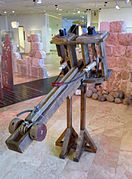
Ballista (torsion)

Bucket onager (torsion artillery often mistaken for a medieval mangonel)

Sling onager (4th-6th century torsion weapon)
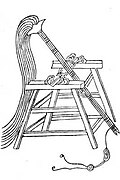
Traction trebuchet (what is usually meant by a "mangonel" in medieval times)

Counterweight trebuchet (12th-15th century siege weapon)
Springald (defensive torsion bolt thrower from 13-14th centuries)
History[]


The mangonel is thought to have originated in ancient China.[5][33][34] Torsion-based siege weapons such as the ballista and onager are not known to have been used in China.[35]
The first recorded use of mangonels was in ancient China. They were probably used by the Mohists as early as 4th century BC, descriptions of which can be found in the Mojing (compiled in the 4th century BC).[33][34] According to the Mojing, the mangonel was 17 feet high with four feet buried below ground, the fulcrum attached was constructed from the wheels of a cart, the throwing arm was 30 to 35 feet long with three quarters above the pivot and a quarter below to which the ropes are attached, and the sling two feet and eight inches long. The range given for projectiles are 300, 180, and 120 feet. They were used as defensive weapons stationed on walls and sometimes hurled hollowed out logs filled with burning charcoal to destroy enemy siege works.[36][37] By the 1st century AD, commentators were interpreting other passages in texts such as the Zuo zhuan and Classic of Poetry as references to the mangonel: "the guai is 'a great arm of wood on which a stone is laid, and this by means of a device [ji] is shot off and so strikes down the enemy.'"[38] The Records of the Grand Historian say that "The flying stones weigh 12 catties and by devices [ji] are shot off 300 paces."[38] They were commonly called stone-throwing machines, thunder carriages, and stone carriages in the following centuries.[39] They were used as ship mounted weapons by 573 for attacking enemy fortifications.[39] In 617 Li Mi (Sui dynasty) constructed 300 mangonels for his assault on Luoyang, in 621 Li Shimin did the same at Luoyang, and onward into the Song dynasty when in 1161, mangonels operated by Song dynasty soldiers fired bombs of lime and sulphur against the ships of the Jin dynasty navy during the Battle of Caishi.[40][41]
The mangonel was carried westward by the Avars and appeared next in the eastern Mediterranean by the late 6th century AD, where it replaced torsion powered siege engines such as the ballista and onager due to its simpler design and faster rate of fire.[4][5][6] The Byzantines adopted the mangonel possibly as early as 587, the Persians in the early 7th century, and the Arabs in the second half of the 7th century.[35] Like the Chinese, by 653, the Arabs also had ship mounted mangonels.[42] The Franks and Saxons adopted the weapon in the 8th century.[43] In 1173, the Republic of Pisa tried to capture an island castle with mangonels on galleys.[44]
The catapult, the account of which has been translated from the Greek several times, was quadrangular, with a wide base but narrowing towards the top, using large iron rollers to which were fixed timber beams "similar to the beams of big houses", having at the back a sling, and at the front thick cables, enabling the arm to be raised and lowered, and which threw "enormous blocks into the air with a terrifying noise".[45]
— Peter Purton
The traction trebuchet displaced classical, torsion-powered artillery because it was simpler and required less competence to build, while maintaining comparable range and power, and it had far higher rates of firing and accuracy (when operated by a trained crew). Furthermore, it was probably safer to operate than tension weapons, whose bundles of taut sinews stored up huge amounts of energy even in resting state and were prone to catastrophic failure when in use.[46]
— Inge Ree Peterson
According to Leife Inge Ree Peterson, a mangonel could have been used at in 421 but was "likely an onager".[47] He also claims that mangonels were independently invented or at least known in the Eastern Mediterranean by 500 AD based on records of different and better artillery weapons, however there is no explicit description of a mangonel. Furthermore mangonels were used in Spain and Italy by the mid 6th century and in Africa by the 7th century. The Franks adopted the weapon in the 8th century.[48]
Thus, on the basis of fairly hard evidence of unknown machinery in Joshua the Stylite and Agathias, as well as good indications of its construction in Procopius (especially when read against Strategikon), it is likely that the traction trebuchet had become known in the eastern Mediterranean area at the latest by around 500. The philological and (admittedly circumstantial) historical evidence may even support a date around 400.[49]
— Inge Ree Peterson
West of China, the mangonel remained the primary siege weapon until the 12th century when it was replaced by the counterweight trebuchet.[50] In China the mangonel continued to be used until the counterweight trebuchet was introduced during the Mongol conquest of the Song dynasty in the 13th century.[51] The counterweight trebuchet did not completely replace the mangonel. Despite its greater range, counterweight trebuchets had to be constructed close to the site of the siege unlike mangonels, which were smaller, lighter, cheaper, and easier to take apart and put back together again where necessary.[52] The superiority of the counterweight trebuchet was not clear cut. Of this, the Hongwu Emperor stated in 1388: "The old type of trebuchet was really more convenient. If you have a hundred of those machines, then when you are ready to march, each wooden pole can be carried by only four men. Then when you reach your destination, you encircle the city, set them up, and start shooting!"[53] The mangonel continued to serve as an anti-personnel weapon. The Norwegian text of 1240, Speculum regale, explicitly states this division of functions. Mangonels were to be used for hitting people in undefended areas.[54]

Crouching tiger trebuchet from the Wujing Zongyao
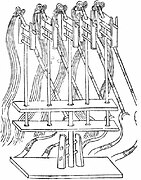
Five whirlwind trebuchets from the Wujing Zongyao
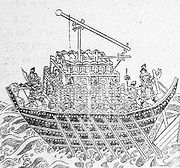
Traction trebuchet on a Song Dynasty warship from the Wujing Zongyao
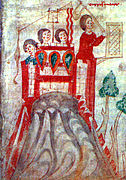
12th century depiction of a traction trebuchet (also called a perrier) next to a staff slinger

Early 13th century Sicilian-Byzantine depiction of a traction trebuchet

13th century depiction of a traction trebuchet

Muslim traction trebuchet, 1285
See also[]
References[]
- ^ "What is a catapult?". RLT Industries. Archived from the original on 2000-12-06. Retrieved 2009-01-12.
- ^ "Mangonel". middle-ages.org.uk. Retrieved 2009-01-12.
- ^ from Old French or Norman mangonel(le), French mangoneau, itself from Medieval Latin manganellus, mangonellus, from Greek μάγγανον meaning "engine of war", "axis of a pulley". T. F. Hoad, The Concise Oxford Dictionary Of English Etymology, Oxford Paperbacks, Oxford University Press, 1993, p. 280a.
- ^ Jump up to: a b Purton 2009, p. 366.
- ^ Jump up to: a b c Chevedden, Paul E.; et al. (July 1995). "The Trebuchet". Scientific American: 66–71. http://static.sewanee.edu/physics/PHYSICS103/trebuchet.pdf Archived 2015-06-15 at the Wayback Machine. Original version.
- ^ Jump up to: a b Graff 2016, p. 141.
- ^ Jump up to: a b Purton 2006, p. 89.
- ^ Konstantin Nossov; Vladimir Golubev. Ancient and Medieval Siege Weapons: A Fully Illustrated Guide to Siege Weapons and Tactics.
- ^ Larry J. Simon; Robert Ignatius Burns; Paul E. Chevedden; Donald J. Kagay; Paul G. Padilla. Iberia and the Mediterranean World he Middle Ages: Studies in Honor of Robert I. Burns, S.J.
- ^ Purton 2009, p. 411.
- ^ Dufour, 97,99; Bonaparte, 26.
- ^ Fulton 2016, p. 12.
- ^ Köhler, 139-211
- ^ Fulton 2016, p. 16.
- ^ Schneider, 10-16.
- ^ Fulton 2016, p. 14.
- ^ Huuri, 51-63, 212-214.
- ^ Rogers, 254-273.
- ^ Jump up to: a b Purton 2006, p. 80.
- ^ Fulton 2016, p. 11.
- ^ Bradbury, 256-257; Hacker, 43.
- ^ Fulton 2016, p. 10-11.
- ^ Purton 2006, p. 85.
- ^ Fulton 2016, p. 13.
- ^ Purton 2009, p. 172.
- ^ Nicolle 2002, p. 9-10.
- ^ Bradbury, 251.
- ^ Abbo Cernuus, Bella Parisiacae urbis[1]; Bradbury, 252.
- ^ Bradbury, 254.
- ^ Fulton 2016, p. 17.
- ^ Purton 2009, p. 365.
- ^ Purton 2009, p. 410.
- ^ Jump up to: a b The Trebuchet, Citation:"The trebuchet, invented in China between the fifth and third centuries B.C.E., reached the Mediterranean by the sixth century C.E. "
- ^ Jump up to: a b PAUL E. CHEVEDDEN, The Invention of the Counterweight Trebuchet: A Study in Cultural Diffusion Archived 2014-06-10 at the Wayback Machine, p.71, p.74, See citation:"The traction trebuchet, invented by the Chinese sometime before the fourth century B.C." in page 74
- ^ Jump up to: a b Graff 2016, p. 86.
- ^ Liang 2006.
- ^ Needham 1994, p. 207-209.
- ^ Jump up to: a b Needham 1994, p. 206.
- ^ Jump up to: a b Needham 1994, p. 210.
- ^ Needham, Joseph (1987). Science and Civilisation in China: Military technology: The Gunpowder Epic, Volume 5, Part 7. Cambridge University Press. p. 166. ISBN 978-0-521-30358-3.
- ^ Franke, Herbert (1994). Denis C. Twitchett; Herbert Franke; John King Fairbank (eds.). The Cambridge History of China: Volume 6, Alien Regimes and Border States, 710–1368. Cambridge University Press. pp. 241–242. ISBN 978-0-521-24331-5.
- ^ Purton 2009, p. 47.
- ^ Purton 2009, p. 367.
- ^ Purton 2009, p. 291.
- ^ Purton 2009, p. 30.
- ^ Peterson 2013, p. 409.
- ^ Peterson 2013, p. 275.
- ^ Peterson 2013, p. 421-423.
- ^ Peterson 2013, p. 421.
- ^ Purton 2009, p. 29.
- ^ Jasper Becker (2008). City of heavenly tranquility: Beijing in the history of China (illustrated ed.). Oxford University Press. p. 64. ISBN 978-0195309973. Retrieved 2010-10-28.
- ^ Turnbull 2001, p. 33.
- ^ Needham 1994, p. 229.
- ^ Purton 2009, p. 386.
Bibliography[]
- Chevedden, Paul E.; et al. (July 1995). "The Trebuchet" (PDF). Scientific American: 66–71. Archived from the original (PDF) on 2012-01-11.. Original version.
- Chevedden, Paul E. (2000). "The Invention of the Counterweight Trebuchet: A Study in Cultural Diffusion". Dumbarton Oaks Papers. 54: 71–116. doi:10.2307/1291833. JSTOR 1291833.
- Dennis, George (1998). "Byzantine Heavy Artillery: The Helepolis". Greek, Roman, and Byzantine Studies (39).
- Fulton, Michael S. (2016), Artillery in and around the Latin East
- Graff, David A. (2016), The Eurasian Way of War Military Practice in Seventh-Century China and Byzantium, Routledge
- Gravett, Christopher (1990). Medieval Siege Warfare. Osprey Publishing.
- Hansen, Peter Vemming (April 1992). "Medieval Siege Engines Reconstructed: The Witch with Ropes for Hair". Military Illustrated (47): 15–20.
- Hansen, Peter Vemming (1992). "Experimental Reconstruction of the Medieval Trebuchet". Acta Archaeologica (63): 189–208. Archived from the original on 2007-04-03.
- Jahsman, William E.; MTA Associates (2000). The Counterweighted Trebuchet – an Excellent Example of Applied Retromechanics.
- Jahsman, William E.; MTA Associates (2001). FATAnalysis (PDF).
- Archbishop of Thessalonike, John I (1979). Miracula S. Demetrii, ed. P. Lemerle, Les plus anciens recueils des miracles de saint Demitrius et la penetration des slaves dans les Balkans. Centre National de la Recherche Scientifique.
- Liang, Jieming (2006). Chinese Siege Warfare: Mechanical Artillery & Siege Weapons of Antiquity – An Illustrated History.
- Needham, Joseph (2004). Science and Civilization in China. Cambridge University Press. p. 218.
- Needham, Joseph (1986). Science and Civilization in China: Volume 4, Part 2. Taipei: Caves Books, Ltd.
- Needham, Joseph (1994), Science and Civilization in China 5-6
- Nicolle, David (2002), Medieval Siege Weapons 1, Osprey Publishing
- Payne-Gallwey, Sir Ralph (1903). "LVIII The Trebuchet". The Crossbow With a Treatise on the Balista and Catapult of the Ancients and an Appendix on the Catapult, Balista and Turkish Bow (Reprint ed.). pp. 308–315.
- Peterson, Leif Inge Ree (2013), Siege Warfare and Military Organization in the Successor States, Brill
- Purton, Peter (2006), The myth of the mangonel: torsion artillery in the Middle Ages
- Purton, Peter (2009), A History of the Early Medieval Siege c.450-1200, The Boydell Press
- Saimre, Tanel (2007), Trebuchet – a gravity operated siege engine. A Study in Experimental Archaeology (PDF)
- Siano, Donald B. (November 16, 2013). Trebuchet Mechanics (PDF).
- Al-Tarsusi (1947). Instruction of the masters on the means of deliverance from disasters in wars. Bodleian MS Hunt. 264. ed. Cahen, Claude, "Un traite d'armurerie compose pour Saladin". Bulletin d'etudes orientales 12 [1947–1948]:103–163.
- Turnbull, Stephen (2001), Siege Weapons of the Far East (1) AD 612-1300, Osprey Publishing
External links[]
| Wikimedia Commons has media related to Traction trebuchets. |
- Res Gestae, 4th century, by Ammianus Marcellinus
- Medieval Mechanical Artillery, by the Xenophon Group
- Onager Physics. An analysis of the Onager/Mangonel
- Mangonel Animation
- Ancient artillery
- Artillery of China
- Chinese inventions
- Medieval siege engines
- Roman siege engines













